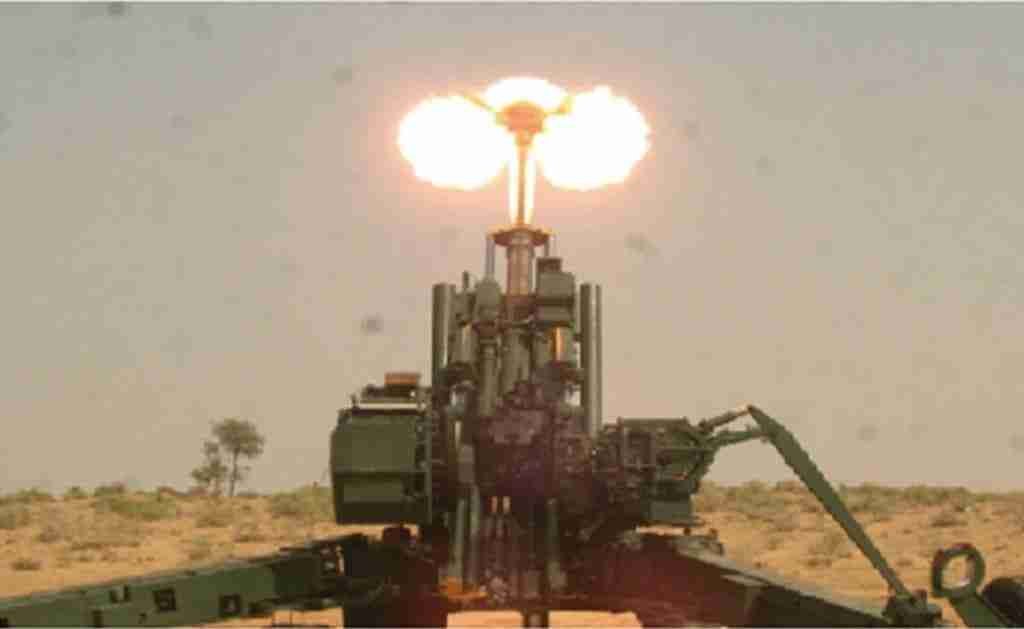From, the Maritime Safety Committee of the International Maritime Organisation (IMO), officially recognising NavIC as a component of the World-Wide Radio Navigation System (WWRNS), making India the fourth country to receive such recognition, to new Carbines for the Army, to latest on Astra Missile and ATAGS for the Army, there is a lot that happened in the defence sector. Salute brings you the news.
IMO RECOGNISES INDIA’S NAVIC
The Indian Regional Navigation Satellite System (IRNSS), also called NavIC, (Acronym for Navigation with Indian Constellation. Navic is also a Hindi word for sailor or navigator) is an independent regional navigation satellite system developed by India. The name Navic was given by Prime Minister Narendra Modi after the successful launch of the seventh navigation satellite, in April 2016. As of now it covers India and an area 1500 km around it and provides accurate real-time positioning and timing services.
The constellation consists of 8 satellites of which three satellites are located in geostationary orbit (GEO) and the remaining five are in inclined geosynchronous orbit (GSO). The system is under complete Indian control, with the space segment, ground segment and user receivers all being built in India.
The Maritime Safety Committee of the International Maritime Organisation (IMO), in its 102nd meeting(MSC-102) on 8 December 2020, officially recognised NavIC as a component of the World-Wide Radio Navigation System (WWRNS), making India the fourth country to receive such recognition. During this meeting, NavIC was represented by the Directorate General of Shipping (DGS), Ministry of Ports, Shipping and Waterways with technical support from ISRO.
Earlier, in April 2020, NavIC L5 was incorporated in the Radio Technical Commission for Maritime Services (RTCM) standard 10403.3 for differential Global Navigation Satellite System (GNSS) applications.

According to ISRO, IRNSS will provide two types of services, namely, Standard Positioning Service (SPS) which is provided to all the users and Restricted Service (RS), which is an encrypted service provided only to the authorised users like the Indian Military.
NavIC is stated to provide a position accuracy of under 20 metres in the primary service area. It can thus be used to assist in the navigation of ships in the Indian Ocean waters and for Indian users, could replace the US-owned Global Positioning System (GPS). It also offers services like terrestrial and marine navigation, disaster management, vehicle tracking and fleet management, navigation aide for hikers and travellers, visual and voice navigation for drivers etc.
The US Congress formally acknowledged India’s NavIC global navigation satellite system (GNSS) to be an “allied system” in its finalised 2020 National Defense Authorization Act (NDAA). This is the legislative bill that outlines the US Department of Defense’s budget, policies, and priorities for the coming fiscal year. This puts India’s NavIC at par with Japan’s GNSS Quasi-Zenith Satellite System (QZSS) and Europe’s Galileo GNSS. The US military and government users can now utilise NavIC along with the US Global Positioning System (GPS), QZSS, and Galileo.
Presumably, it will also allow similar privileges for India’s military and government to formally utilise GPS. Users outside of India can improve NAVIC position accuracy by using differential techniques where a network of fixed, ground-based reference stations broadcast the difference between the positions indicated by the NavIC satellites and the known fixed positions.
The Indian government, as part of its plans to commercialise the use of NavIC and to promote an indigenous positioning technology, is encouraging firms to design develop, and deploy integrated NavIC and GPS receiver chipsets. India will thus have its very own GPS, which cannot be cut off by external agencies, especially in times of conflict.
NEW CARBINE FOR THE ARMY
The World War II vintage 9 mm carbine is finally being replaced by the 5.56×30 mm Joint Venture Protective Carbine (JVPC). The process for replacing the 9 mm carbine was initiated by the Indian Army in 2006, and after 14 years, the JVPC has now met the Army’s GSQR and will soon be inducted into service.
The 9 mm carbine had many problems, especially in close combat situations. It had comparatively lower reliability, being prone to faults and accidents and did not compare well with the AK 47 rifles being used by terrorists. Both the DRDO and the Ordnance Factory Board (OFB) competed for making a new carbine for the military. The OFB designed and developed the Amogh Carbine. This was a 5.56×30 mm fully automatic carbine, which was a derivative of the Excalibur rifle. The DRDO produced the Modern Sub Machine Carbine (MSMC) carbine, after the Indian Army’s disappointment with the performance of the Amogh carbine. Finally, both DRDO and OFB got together to produce the JVPC.

Trials for the carbine have been carried out in all weather and in all-terrain conditions. Final user trials for the JVPC were successfully carried out on 7 December 2020, wherein all the GSQR parameters were met, paving the way for its induction into the Armed Forces. The weapon will also be inducted for the Central Armed Police Forces (CAPF) and the various state police forces.
Features

JVPC is a Gas Operated Semi Bull-pup automatic weapon with key features like high reliability, low recoil, retractable butt, ergonomic design, single hand firing capability, and multiple Picatinny rails etc. These features make it a very potent weapon for Counter Insurgency/Counter-Terrorism operations. Designed by Armament Research and Development Establishment (ARDE), the carbine will be manufactured at Small Arms Factory, Kanpur while the Ammunition will be produced at ammunition Factory, Kirkee Pune.
INDIA’S ASTRA MISSILE
Astra is India’s first indigenously developed Beyond Visual Range Air-to-Air Missile (BVRAAM), capable of engaging highly manoeuvring supersonic aircraft. Developed by the Defence Research and Development Organisation (DRDO), along with almost 50 other public and private organisations, which were involved in multiple variants to meet specific requirements, the Astra Mk 1 missile has been integrated with the Su 30 Mk 1 aircraft.
Astra Mk 1 is an all-weather day and night capability missile with a 15-kilogram high-explosive pre-fragmented warhead and a range of 110 km. and flying speed of over 5,555 km per hour. The missile will soon be integrated into the Tejas fighter jets and on the MiG-29 fighters, marking another important milestone in India’s quest for self-sufficiency and enhancing the potency of the Tejas. Initial ground trials for the integration and flight trials will commence in 2021. DRDO is now working on the Mark-2 version of Astra, which will have a dual-pulse rocket motor to enable the missile to achieve a range of 160 km. A Mark 3 version, is also being planned which will have a range of 350 kms.

All subsystems of the Astra missile except the RF seeker and the inertial measurement unit (IMU), are indigenous. The seekers are being indigenised by Bharat Electronics Limited and will be inducted by June 2021. The IMU will also be indigenised, making the missile a complete Indian product.
The Astra missile will eventually replace Russian, French and Israeli BVRAAMs equipped on IAF fighter jets. Produced by Bharat Dynamics Limited, this missile will eventually be the standard BVRAAM across India’s entire fighter fleet, except the French-origin Rafale and Mirage. The Defence Ministry formally sanctioned the purchase of 248 Astra missiles, including 48 for the Navy, after a successful September 2019 trial in which it hit a target 90 km away.
ATAGS FOR THE ARMY
The Advanced Towed Artillery Gun System (ATAGS) is an ambitious project of the Indian Army to modernise its artillery regiments with the 155 mm artillery gun. The project which began in 2013, had the DRDO laboratory Armament Research and Development Establishment (ARDE) partnering private sector corporates Bharat Forge Limited, Mahindra Defence Naval System and Tata Power Strategic Engineering Division and the Ordnance Factory Board (OFB) to produce the gun.

Following a mishap during tests in Pokhran in September 2020, the user trials for ATAGS had stalled, but testing has now resumed. The gun is likely to be approved for induction after the completion of winter trials in Sikkim in early 2021 and mobility trials thereafter in summer. It can possibly fulfil the complete requirement of the Army, which stands at about 2000 guns.
The ATAGS has 95 per cent indigenous content, making it a truly ‘Made in India’ weapon. It has a dual power system that integrates hydraulics for improved mobility and in/out action, making the gun suitable for deployment in different types of terrain, from deserts to high altitude areas.
It can fire three rounds in 15 seconds in burst mode, and 60 rounds in 60 minutes in sustained mode, and that, combined with its long-range of 48 km, makes it indeed a very potent weapon system. The gun reportedly has ‘all-electric drive technology’, and is accurate and reliable. Its induction into the Army will greatly enhance the capability of the Artillery.


